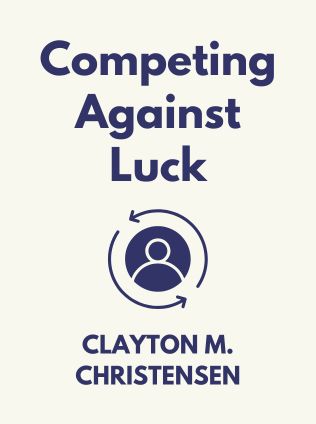
Competing Against Luck
The Story of Innovation and Customer Choice
By Clayton M. Christensen,
Published 10/2016
About the Author
Clayton M. Christensen, a professor at Harvard Business School, is recognized globally as an authority on innovation strategy and growth. His profound insights have earned him the title of the most influential living management thinker by Thinkers50 in 2013. Alongside Christensen, the book "Competing Against Luck" is co-authored by Taddy Hall, a principal at the Cambridge Group, and leader of the Nielsen Breakthrough Innovation Project; Karen Dillon, former editor of the Harvard Business Review and co-author of "How Will You Measure Your Life?" with Christensen; and David S. Duncan, a senior partner at Innosight and a prominent advisor on innovation strategy and growth. Together, they bring a wealth of experience and knowledge, making "Competing Against Luck" a critical read for understanding and mastering the art of innovation.
Main Idea
The central thesis of "Competing Against Luck" is the "Jobs to Be Done" theory. This theory challenges the traditional approach to innovation, which relies heavily on understanding customers' needs and behaviors. Instead, the authors argue that innovation success stems from understanding the specific "jobs" that customers hire products or services to do. By focusing on the progress that customers are trying to achieve in their lives, businesses can create products that are not only desirable but also indispensable. This approach transforms innovation from a game of chance into a predictable and reliable process.
Table of Contents
- Introduction to Jobs Theory
- The Milkshake Dilemma
- Progress, Not Products
- Shifting Competitive Landscape
- Jobs in the Wild
- Job Hunting
- How to Hear What Your Customers Don’t Say
- Building Customer Stories
- Building Your Résumé
- The Jobs to Be Done Organization
- Integrating Around a Job
- Keeping Your Eye on the Job
Introduction to Jobs Theory
The book opens by introducing the core concept of Jobs Theory. Traditional innovation methods focus on customer demographics and behaviors, but Christensen and his co-authors argue that these methods fail to predict successful innovation consistently. Instead, they propose understanding the jobs that customers are trying to get done in their lives. This shift in perspective reveals deeper insights into why customers make certain choices, leading to more effective product development and marketing strategies.
"Customers don’t buy products or services; they pull them into their lives to make progress." - Clayton M. Christensen
This foundational idea sets the stage for a comprehensive exploration of how companies can leverage the Jobs Theory to innovate more effectively. The authors emphasize that understanding the job to be done is more predictive of successful innovation than traditional customer-centric approaches.
The Milkshake Dilemma
The authors illustrate the Jobs Theory with a compelling story about a fast-food chain struggling to increase milkshake sales. Traditional market research failed to boost sales despite extensive data collection and customer feedback. The breakthrough came when researchers observed customers' behavior and discovered that morning commuters were hiring milkshakes to make their commutes more enjoyable. This insight led to product modifications that significantly improved sales.
- Morning commuters hired milkshakes to make long drives enjoyable.
- Parents hired milkshakes to treat their children in the afternoons.
This story highlights the importance of context in understanding customer behavior. By focusing on the circumstances in which customers hired the product, the fast-food chain was able to tailor its offerings to better meet their needs. This approach contrasts sharply with the traditional method of averaging customer feedback, which often results in products that fail to satisfy anyone fully.
Sign up for FREE and get access to 1,400+ books summaries.
You May Also Like
The Lean Startup
How Today's Entrepreneurs Use Continuous Innovation to Create Radically Successful Businesses
By Eric RiesWho Moved My Cheese?
An Amazing Way to Deal with Change in Your Work and in Your Life
By Spencer Johnson, M.D.Make Your Bed
Little Things That Can Change Your Life...And Maybe the World
By William H. McRavenThe Ride of a Lifetime
Lessons Learned from 15 Years as CEO of the Walt Disney Company
By Robert Iger



















